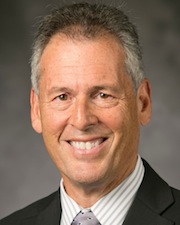Questioning the Calculations |
College Promise Programs | Donate! 


What’s AHEAD Commentary [Poll 8]
To join the discussion on these commentaries, please visit our Facebook page:
https://www.facebook.com/PennAHEAD
Sexual Violence on Campus
In our eighth What’s AHEAD poll, we focused on sexual violence on campus. We invited four leading scholar-practitioners to comment: Dr. Larry Moneta of Duke University, Dr. Sandra Johnson of the Rochester Institute of Technology, Dr. Dawn Pleas-Bailey of Southwestern College, and Dr. Jason Rogers of Belmont University. Drs. Johnson, Pleas-Bailey, and Rogers are Penn GSE alumni.
Sexual Violence on College Campuses: Obligation and Duty to Respond

Larry Moneta
Vice President for Student Affairs
Duke University
Concerns with higher education’s attention to sexual violence persist despite ongoing institutional prevention and intervention efforts. While many institutions will insist on having had significant focus on this pernicious issue, few can dispute the call to action stimulated by the Office of Civil Rights’ (OCR) ‘Dear Colleague’ letter of April 2011. From that day on, through the 2013 passage of the Campus SAVE Act and with the pending passage of the Campus Accountability and Safety Act (CASA), colleges and universities have been put on notice that whatever effort and investment has been extended in the past is insufficient for the future.
The What’s AHEAD poll on sexual violence on campus offers few surprises but affirms what institutions assert: the topic is of growing, critical importance; current policies and practices are inadequate to address the needs; and further efforts to prevent incidents of sexual violence are needed. But, the results also reveal contradictions with other survey results and public sentiments. For example, 71% of respondents believe that institutional policies are communicated clearly, while a study commissioned by Senator McCaskill suggests substantially differing results. Further, the McCaskill report criticizes colleges and universities for their failure to collect sufficient information about campus climate regarding sexual violence while the What’s AHEAD results note that more than half of respondents (59%) say that available data are adequate to understand institutional needs.
What we can be certain of is further pressure to conform to national expectations and, inevitably, rules and laws that will require far greater investment in efforts to prevent and respond to sexual violence. And, even as campuses struggle to accommodate regulatory compliance, they will face growing backlash from those held accountable who will argue that federal and institutional efforts are biased in favor of victims/survivors. The Safe Campus Act, also working its way through Congress, precisely reflects the sentiments of those who believe the pendulum has swung too far in favor of sexual violence complainants.
What is clear is that higher education leaders must be attentive, well advised, responsive and fair in attending to sexual violence on their campuses. With well over 100 institutions now subject to OCR complaints and average resolution times running close to three years, there is little chance of diminished attention to sexual violence. Nor should there be.
Compliance or Cultural Shift?

Sandra S. Johnson
Senior Vice President for Student Affairs
Rochester Institute of Technology
It is evident in the tenor from media reports, climate data, the outcry from students on college campuses across the United States, and from responses to the What’s AHEAD poll that sexual violence is a major area of concern, not only among higher education leaders, but also the public and state and federal policymakers. Across the board you find the same message: there are no magic bullets to “fix” the problem.
As a result of the attention from recent reports and increased state and federal regulations, as a higher education professional I have found my work to be increasingly focused on monitoring institutional compliance with regulatory requirements as opposed to what I believe is needed—a comprehensive and holistic approach that combines continuous campus-wide education about sexual violence with effective institutional policies, practices, and structures. The focus on ensuring compliance with regulatory mandates has reached a critical tipping point as evidenced by a colleague who commented that their title should be changed to “vice president for sexual assault and alcohol,” because that is where 80% of their attention is being directed.
I am not implying that sexual violence is not a major problem on college campuses today—it is—rather I believe we missed an important step in the problem solving process: collaboration among higher education leaders, experts in the field, and policymakers. Taking the collective approach would allow us to actively cultivate a ground swell of support and capitalize on our respective areas of expertise to re-tool policies, increase awareness, and create supportive campus structures. Without transformational thinking and innovative adjustments, incidents of sexual violence will remain unchanged. We need to shift the focus on compliance to promoting campus-wide understanding and a collective commitment to creating a culture of care and respect.
The Best Title IX Administrators Are NEVER Comfortable
Dawn Pleas-Bailey
Vice President of Retention and Student Success
Special Assistant to the President for Community Engagement
Southwestern College
The best Title IX administrators are NEVER comfortable. Despite their understanding of the students, the college, the president, and the culture, they always wonder “what if?” In the world of sexual assault on college campuses, the issues are real, intense, embarrassing, complex, and often contradictory. The ability to balance federal requirements, while needing to change campus culture is overwhelming, especially when the same administrators charged with Title IX are responsible for a myriad of other essential tasks at their institutions. It is quite easy to feel inadequate in facing the duties associated with all of these expectations.
I wonder, though if we would CARE as much about Title IX issues if the repercussions were not so daunting and publicly embarrassing. I know we often feel overwhelmed by the heavy weight of compliance, complexity, and federal mandates, but maybe that is a good thing.
We exist for a greater purpose to our education learners. Not only in an academic sense, but to help them become responsible citizens of this world. If we have created an environment that allows sexual assault to exist and flourish, then it is our responsibility to figure out how to remove this problem from our campus communities.
So, in assessing how institutional leaders feel about addressing compliance, I want us also to always remember whom we serve—the student. It’s those individuals who we need to protect from being a possible victim or an alleged perpetuator of a horrific incident. That is why this process NEEDS to feel overwhelming.
Common Experiences and Shared Challenges

Jason B. Rogers
Vice President for Administration and University Counsel
Belmont University
The results of the What’s AHEAD poll on sexual violence on campus reflect a high level of consensus in response to several survey questions. This consensus is undoubtedly due to the common experience we higher education professionals share in responding to the steady stream of data and publicity on this topic from students and their families, the media, the federal government, and our professional organizations.
The Office for Civil Rights’ Guidance from April 2014 expanded the scope of individuals whom many of our institutions considered to be within the definition of “responsible employee.” The new definition broadened the conversation about sexual assault and related misconduct on many of our campuses. In the wake of that Guidance, our institutions have retooled our policies, trained and retrained our faculty and staff, and expanded the educational outreach to students.
As a result, many of us are experiencing an expected and dramatic increase in the number of incidents of sexual misconduct reported by our students, especially among students who knew each other prior to an incident. As we all pursue our goals of preventing and addressing sexual assault in our campus communities, our challenges will be to maintain the current high level of attention to education and outreach and to continually improve internal adjudication processes to justly and fairly protect the rights of victims and accused alike.
To join the discussion on these commentaries, please visit our Facebook page: https://www.facebook.com/PennAHEAD



